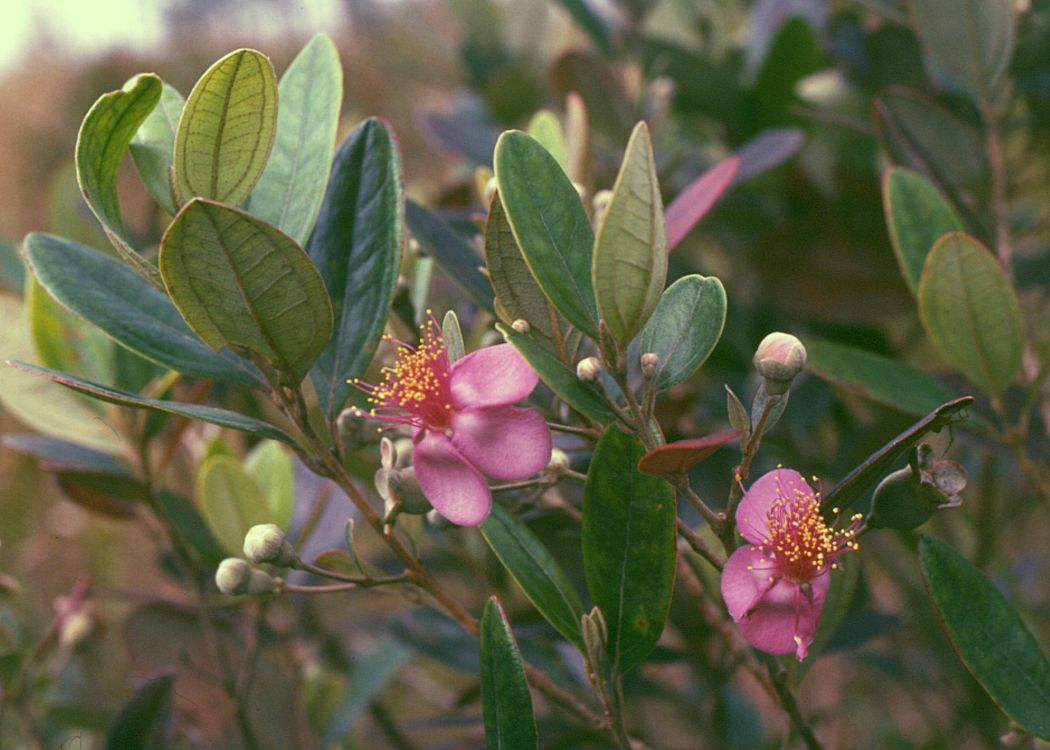- Rhodomyrtus tomentosa
taxobox
name = "Rhodomyrtus tomentosa"
status = LC
regnum =Plantae
unranked_divisio =Angiosperm s
unranked_classis =Eudicot s
unranked_ordo =Rosid s
ordo =Myrtales
familia =Myrtaceae
genus = "Rhodomyrtus "
species = "R. tomentosa"
binomial = "Rhodomyrtus tomentosa"
binomial_authority = (Aiton) Hassk.|"Rhodomyrtus tomentosa" is a
flowering plant in the familyMyrtaceae , native to southern and southeasternAsia , fromIndia , east to southernChina ,Taiwan and thePhilippines , and south toMalaysia andSulawesi . It grows incoast s, natural forest,riparian zone s,wetland s, moist and wet forests,bog margins, from sea level up to 2400 m elevation [Hosaka and Thistle, 1954 in Langeland and Burks, 1999] .It is an
evergreen shrub growing up to 4 m tall. The leaves are opposite, leathery, 5-7 cm long and 2-3.5 cm broad, three-veined from the base, oval, obtuse to sharp pointed at the tip, glossy green above, densely grey or rarely yellowish-hairy beneath, with a wide petiole and an entire margin. Theflower s are solitary or in clusters of two or three, 2.5-3 cm diameter, with fivepetal s which are tinged white outside with purplish-pink or all pink. Thefruit is edible, 10-15 mm long, purple, round, three or four-celled, capped with persistent calyx lobes, soft, with 40-45seed s in a double row in each cell; seed dispersal is by frugivorous birds and mammals. Seed production andgermination rates are high. ["Flora of Taiwan" [http://tai2.ntu.edu.tw/udth/bin/fot1.exe/browse?bid=3&page=890 6: 890] , [http://tai2.ntu.edu.tw/udth/bin/fot1.exe/browse?bid=3&page=891 plate 443] ] , [Huxley, A., ed. (1992). "New RHS Dictionary of Gardening" 4: 79. Macmillan.] , [Center for Natural Resources, 2003] .Synonyms include "Myrtus canescens" Lour., "Myrtus tomentosa" Aiton, "Rhodomyrtus parviflora" Alston, and "Rhodomyrtus tomentosa" (Aiton) Wight. Common names include Ceylon hill gooseberry (English), Downy myrtle (English-Florida), Downy rose myrtle (English-Florida), Feijoa (French), Hill gooseberry (English), Hill guava (English), Isenberg bush (English-Hawaii), Myrte-groseille (French), and Rose myrtle (English-Florida) [http://www.issg.org/database/species/search.asp?sts=sss&st=sss&fr=1&sn=Rhodomyrtus+tomentosa&rn=&hci=-1&ei=-1&x=29&y=7] .
Cultivation and uses
It has shown promise as a
fire retardant species for use infire break s in theHimalayas . [Ministry of Environment & Forests, 2003] It is a popularornamental plant in gardens intropical andsubtropical areas, grown for its abundant flowers and sweet, edible fruit. [Center for Natural Resources, 2003] The fruit can be made intopies andjams , or used insalads . In Vietnam, the fruits are used to produce a wine called "rượu sim".Management
It has become an
invasive species in some countries, spreading to form large,monospecific thickets that displace nativeflora andfauna . Areas especially affected includeFlorida ,Hawaii , andFrench Polynesia .It is able to invade a range of habitats, from pine flatwoods to
mangrove marshes [Center for Natural Resources, 2003] . It grows in a wide range ofsoil types, including salty coastal soil, but is sensitive to heavy salt spray. [Menninger, 1964 in Langeland and Burks, 1999] It is fire-adapted, i.e., is able to resprout prolifically after fire. [Center for Aquatic and Invasive Plants, 2001]This species invades the
understory of nativepinelands in Florida, forming dense monoculture thickets that displace native flora and fauna through overcrowding and competition. Has the potential to alter the natural fire regimes of invaded areas. [Center for Aquatic and Invasive Plants, 2001]A risk assessment of "Rhodomyrtus tomentosa" for Hawaii and other Pacific islands was prepared by the [http://www.kaulunani.org/ Kaulunani Urban Forestry Program] and [http://www.fs.fed.us/ US Forest Service] . The [http://www.botany.hawaii.edu/faculty/daehler/WRA/default2.htm alien plant screening system] is derived from Pheloung et al. (1999) with minor modifications for use in Pacific islands. [Daehler et al. 2004] The result is a score of 8 and a recommendation of "Likely to cause significant ecological or economic harm in Hawaii and on other Pacific Islands as determined by a high WRA score, which is based on published sources describing species biology and behavior in Hawaii and/or other parts of the world."
In integrated management,
seedlings can be removed manually. Mature shrubs may be felled using achainsaw or brush cutter, and the stumps treated with a commercialherbicide . [Stocker and Possley 2001]It was introduced to Florida and Hawaii in about 1920 (Degener, 1963 in Langeland and Burks, 1999). In Florida it has now spread to 17 counties (Center for Natural Resources, 2003). On Hawaii it was forming impenetrable thickets on Kauai and Hilo by the 1950s (Hosaka and Thistle, 1954 in Langeland and Burks, 1999). It is currently on the [http://www.hawaiiag.org/hdoa/adminrules/AR-68.pdf State of Hawaii noxious weed list] (Meyer, 1998 in PIER, 2003). [http://www.hear.org/pier/species/rhodomyrtus_tomentosa.htm Rhodomyrtus tomentosa (PIER species info) ] ] Research was conducted at the University of Florida 1998-2000 to describe the ecology and determine effective control methods for this species.
It is also a serious problem on Raiatea, French Polynesia (Meyer, 1998 in PIER, 2003).
References
Wikimedia Foundation. 2010.
